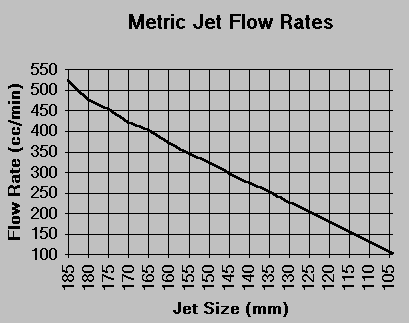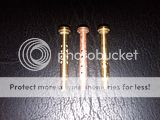Finally after much research and many differing opinions on setting the float, I've found the 35mm/51mm settings allows fuel to flow into the bowl. At 18mm the plastic float wasn't dropping enough to open the needle. The measurement between the top gasket and top of float is now about 12mm. I have the F50 emulsion tube and 3psi set at the regulator and it'll idle about 600rpm. Currently running #50 Idle Jets. Need to fine tune it as it still surges while driving and there is +/-5" of vacuum at the carb port (may put the #55s back in, seemed too rich earlier today). Timing is set at 18* and vacuum reads a steady 10" (too low for my liking) at manifold port. Will try adjusting for best lean at 1,400rpm (read this on the Jeep Forum) and may bump the timing up to 20-22*. Any further comments are welcomed, RodC.
You are using an out of date browser. It may not display this or other websites correctly.
You should upgrade or use an alternative browser.
You should upgrade or use an alternative browser.
Finally Got the Weber 38 to Idle
- Thread starter MT63AFX
- Start date
FALCONAROUND
Well-known member
I have 45's in my 38 and it was so rich I only ran it two day's then went back to starving it with my 32/36..... Gotta jet a wide variety jet pack for it.
You guys are using 1970-1974 old brass jets with Holley Weber imperial stampings. Factory 2.8 liter V6's ran 67 jets (170 micron) in the primary and 49 jets (125 micron) for the secondary in just a Holley Weber 5200.The close limit green jets, and later ones run cc/min or micron sizes. I'm all for the imperial, but I also grew up on these carbs in Pinto engined Cortinas, and a set of 5 thou in call size is freeking huge in flow. We'd change a jet size only in 5 micron steps, which is just 2 imperial call sizes. So if 45, 50, or 55 doesn't work and is too lean, go 47, 52, or 57 equivalents, not 50, 55, or 60.
So #45 would be 152 cc/min or 115 micron
#50 would be 216 cc/min or 127 micron, but correct selections are often 132, which is what a 52 would be if you could get one.
and #55 would be 275 cc/min or 140 micron.
There is a huge difference between sizes, and there is no wonder its taken time for you all to find combinations that work.
Same applies to air correctors. I know you guys have seen http://datsun1200.com/modules/mediawiki ... Carburetor
and our listings on historical jetting by Bigredrasa
What Emulsion tubes are you running, air correctors, and float levels and pressure regulation. The emulsion tubes vary so much, its hard to correlate them.
viewtopic.php?f=1&t=66652&p=511834#p511834
So #45 would be 152 cc/min or 115 micron
#50 would be 216 cc/min or 127 micron, but correct selections are often 132, which is what a 52 would be if you could get one.
and #55 would be 275 cc/min or 140 micron.
There is a huge difference between sizes, and there is no wonder its taken time for you all to find combinations that work.
Same applies to air correctors. I know you guys have seen http://datsun1200.com/modules/mediawiki ... Carburetor
and our listings on historical jetting by Bigredrasa
What Emulsion tubes are you running, air correctors, and float levels and pressure regulation. The emulsion tubes vary so much, its hard to correlate them.
viewtopic.php?f=1&t=66652&p=511834#p511834
xctasy":1xi2gqaj said:That's because the emulsion tube is different. Remember, the 32/36 saw duty on 78 to 171 cube Ford engines from the 87 hp 1.6 liter SOHC Pinto engine found in European Cortinas, Carpis and Sierras, to the US 2600 and 2800 Cologne V6's in the Capri, Bronco II, Areostar. I think the ill fated 1978 to 1980 1600 Kent engined Fiesta ran one for the US market. Both the Weber and Holley Webers use F2 to F78 trim emulsion #61440 tubes, the F50 primary, F6 sec for water or electric choke, F50/F50 for earlier manual choke , but some used for the 171 cube/2800 cc Cologne V6 had F2's in the secondary, and there are other differences to air bleeds. Emission gear forced Ford to adopt different jetting depending if it was Austria, Australia, California or Illonispowerband":1xi2gqaj said:On a fairly high CR 170, I used a generic 4cyl 5200 with all ranges of jetting with little improvement from the 1bbl until finding a 2800 V6 application H/W 5200 version. On the 170 six it improved performance and mileage dramatically . I can't account for differences even swapping same jetting between carb bodies 8) ... But as mentioned it is easy and fun to get the secondaries workin'.. The numbers are just list numbers, but generally, the higher the number, the less the emulsification, the smaller the holes. Low numbers suit bigger engines, generally. Here are the F1 to F20's,with an F8 below. The ink pictures are for #61450 series carbs, but you get the general idea.
http://farm5.static.flickr.com/4101/480 ... c46a_z.jpg
http://farm5.static.flickr.com/4098/480 ... fa40_z.jpg
From swatson454 on speed talk, there are pictures of the normal #61440 series F50, then an F6, an F7, and then a custom moded F7 item. Lastly, some common 32/36 Emulsion tubes from uptillnow


Easy replacements that will fit the 32/36 are F3, 5, 6, 7, 24, 25, 26, 50, 66 and 78. F2's are not commonly available but have been used in 2.8 2-bbl's , while F6's and F66's are other common replacements.
Some Holley Weber 5200 and Weber 32/36 carbs have only a primary idle system, while others have both primary and secondary idle system. These 3 things totally change the make up of any 32/36 or 5200 carb. Every year, there were major changes to carb calibration, and running changes as well. Always without notice...
powerband":1xi2gqaj said:Main Jet Conversions
Green Jets Brass Jets Green Jets Brass Jets
124-227 22R-103-130 124-325 22R-103-150
124-239 22R-103-132 124-346 22R-103-155
124-243 22R-103-133 124-357 22R-103-157
124-255 22R-103-135 124-374 22R-103-160
124-263 22R-103-137 124-404 22R-103-165
124-275 22R-103-140 124-423 22R-103-170
124-283 22R-103-142 124-455 22R-103-175
124-299 22R-103-145 124-477 22R-103-180
124-311 22R-103-147 124-524 22R-103-185
The above are close limit jets
Or the chart that shows all them ploted
And specifically:The earlier standard jet sizes for Holley Webers are:-
103 cc/min=105 microns, or 41.34 thou
128 cc/min=110 microns, or 43.31 thou
152 cc/min=115 microns, or 45.28 thou
178 cc/min=120 microns, or 47.24 thou
201 cc/min=125 microns, or 49.21 thou
225 cc/min=130 microns, or 51.18 thou
251 cc/min=135 microns, or 53.15 thou
275 cc/min=140 microns, or 55.12 thou
298 cc/min=145 microns, or 57.09 thou
325 cc/min=150 microns, or 59.06 thou
346 cc/min=155 microns, or 61.02 thou
375 cc/min=160 microns, or 62.99 thou
400 cc/min=165 microns, or 64.96 thou
425 cc/min=170 microns, or 66.93 thou
450 cc/min=175 microns, or 68.90 thou
475 cc/min=180 microns, or 70.87 thou
525 cc/min=185 microns, or 72.83 thou
Yes, the F2 emulsion tube is around for #61440 carbs, our DGV, DGMS, but also ADM, ICH, and 40/46 IDA Weber
{32/36 DGV, DGAV, 38 DGMS, DGAS, ADM, 40-46 IDA (triple barrel), 34 ICT, 34 ICH and a number of other Weber carburettor models.}
http://www.weberperformance.com.au/prod ... cts_id=973

{32/36 DGV, DGAV, 38 DGMS, DGAS, ADM, 40-46 IDA (triple barrel), 34 ICT, 34 ICH and a number of other Weber carburettor models.}
http://www.weberperformance.com.au/prod ... cts_id=973

xctasy":1b0ybfxi said:Yes, the F2 emulsion tube is around for #61440 carbs, our DGV, DGMS, but also ADM, ICH, and 40/46 IDA Weber
{32/36 DGV, DGAV, 38 DGMS, DGAS, ADM, 40-46 IDA (triple barrel), 34 ICT, 34 ICH and a number of other Weber carburettor models.}
http://www.weberperformance.com.au/prod ... cts_id=973

Thank you for your response. I wasn't aware of the Datsun link, I basically read through the Jeep forum's 38 pages on the Weber (swatson454). Since mine is a Weber 38 DGES I bought the jet kit with the 50-55-60 idle jets and corresponding correctors and main jets. I haven't bought any emulsion tubes as I'm trying to work with the F-50s that are currently in it. I don't recall which main and corrector jets are in it without checking the kit. The idle jets are 45s and with the timing set at 24* it runs quite well. I still haven't got the specs on the cam yet but it'll idle 600-650rpms. I have the float set at the Holley-Weber 5200's, which is probably too high, but haven't noticed any issues yet (may lower back down to 18mm/2mm once the weather warms up a bit, lol). RodC




